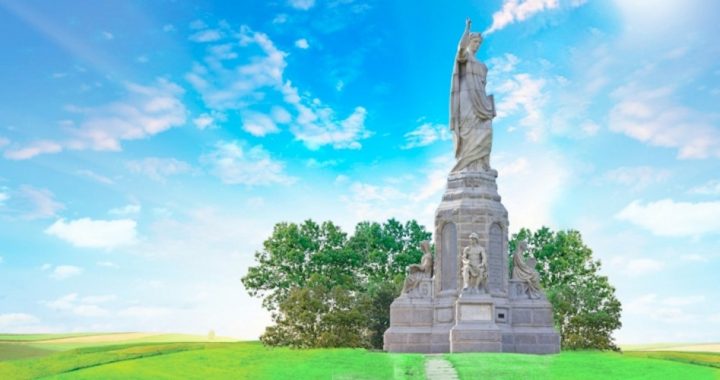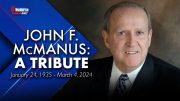
August 1 marked the 125th anniversary of the completion and dedication of one of America’s most ambitious memorials: the Pilgrim’s Monument, now called the National Monument to the Forefathers. Constructed over a period of 30 years in Plymouth, Massachusetts, at the general site where the Pilgrim Fathers had landed in 1620, the National Monument to the Forefathers was dedicated on August 1, 1889, to honor America’s Forefathers, “in remembrance of their labors, sacrifices and sufferings for the cause of civil and religious liberty,” as the monument’s front panel explains.
Standing 81 feet high, the monument is the largest granite sculpture in the U.S., with its most prominent feature a 36-foot-tall, 180-ton statue at its pinnacle representing Faith, the foundation of America’s greatness. Seated on buttresses under Faith are allegorical figures representing four crucial principles upon which America was founded — Morality, Law, Education, and Liberty. Under these stand other principles that are foundational to America’s greatness: flanking Morality are the a Judeo-Christian Old Testament “Prophet” and the New Testament “Evangelist”; under Law stand the tempering ideals of “Justice” and “Mercy”; under Education stand “Youth” and “Wisdom”; and accompanying Liberty are illustrations of “Tyranny Overthrown” and “Peace.”
During a weekend commemoration of the 125th anniversary of the monument’s dedication (July 31-August 2), the hosting organization, Plymouth Rock Foundation, included a special showing of Kirk Cameron’s popular 2012 film Monumental: In Search of America’s National Treasure, the producers of which garnered their inspiration in part from the National Monument to the Forefathers.
At the movie’s debut in 2012, Cameron explained that Monumental represented an effort to show viewers how they could be a part of helping America regain the faith and confidence that characterized the motivation of the nation’s forefathers — a transformation that begins and ends with faith in God. “The biblical method of change begins in the heart of man with the Gospel,” Cameron said. “It transforms the mind of man and gradually works its way out. And it builds a nation from the bottom up.” He added that it also includes parents spending time their children, “teaching them faith, character, and courage, and then over the course of generations you fill the country with men and women of virtue and character, and then they are elected by their peers to be leaders.”
Such was the motivation of another video, produced by Christian Heritage Academy, a private faith-based school in Del City, Oklahoma. The film, funded by a special grant to American Opinion Foundation in conjunction with Freedom Project Media, is a documentary of an historical trip the school’s senior class took in 2012, beginning at Plymouth Rock and winding through a number of historically significant sites, the purpose of which is to demonstrate “God’s Providential plan for the founding of the United States of America,” according to the film’s synopsis.
While the entire movie is well worth viewing, the segment devoted to the Pilgrims (15:00 to 23:15) is particularly inspirational and informative. “Your view of history makes all the difference,” Christian Heritage Academy’s Secondary Headmaster David Holmes told the senior students on the tour, as they stood at Plymouth Rock, the symbolic site of the Pilgrims’ first landing in 1620. He noted that “Karl Marx said, ‘A people without a heritage are easily persuaded,’ meaning that if you don’t understand who you are, and where you came from, you can be persuaded of anything.”
Holmes noted that evil forces have succeeded in persuading many Americans to forget America’s Godly heritage. Jack Clay, one of the school’s staff members and a tour chaperone, emphasized the importance of America’s younger generation remembering the nation’s history and heritage, “because God said, ‘Don’t forget the ancient landmarks’ — remember your heritage. It’s not what man accomplished, but it’s what God has done through those men and in our nation. When we remember, then we understand our purpose.”
One of the most impacting moments of the trip occurred at the National Monument to the Forefathers, where Clay explained to the students that the memorial to America’s forebears has “a tremendous amount of “significance.” Designed by Boston architect Hammatt Billings, the memorial was originally called the “Faith Monument,” because of the giant representation of Faith that predominates the monument.
“There are four things about faith that I want you to notice,” Clay told the students. “First of all in her left hand you’ll find a Bible, and the pages are ruffled, because it is open. And it depicts the Bible that the Pilgrims brought with them from England, the Geneva Bible.”
“The next thing you will notice,” continued Clay, “is that [Faith] has a raised forefinger pointing toward heaven. That’s because the Pilgrims believed there was only one way to heaven, and that was through Jesus Christ alone.” Clay also noted the star on Faith’s forehead, explaining that it represented “the intellectual faith of the Pilgrims.” He went on to note that the Pilgrims believed Scripture “was meant to be applied to every area of life. So they believe that one could reason from Scripture, and determine how to live.”
He also noted that in the monument, Faith is stepping on Plymouth Rock, a representation “that depicts the call of God the Pilgrims believed they had to come to this land to propagate the gospel and to establish a colony where people could worship God freely, own property, where they could enjoy the fruits of their labor, and where they could live in harmony with one another.”
Clay explained that the character of the Pilgrim was one of moral excellence. “On one side of the statue depicting morality,” he said, “you’ll see a prophet, and on the other side you’ll see an evangelist. The prophet represents the Old Testament and the call of God a prophet had. He is looking up toward heaven and receiving his call from God, and declaring the truth.” As for the evangelist, he continued, “he is sowing seed” — a representation of the Christian gospel which the Pilgrims felt strongly was their duty to spread in their new home.
The figure representing law, noted Clay, holds the Ten Commandments while reaching out with the right hand in mercy. “There was a balance, the Pilgrims believed, between justice and mercy,” he explained, “and no one should receive special treatment. Upholding the law was the foundation for their relationships with other people, but justice must be tempered with mercy, they believed.”
Turning to the figure representing education, Clay explained that this virtue was crucial to the Pilgrims. On one side of Education is wisdom, which the Pilgrims “believed was gained from a study of Scripture,” he said. On the other side is a representation of youth, “which is being led by Experience,” he said. “The Pilgrims felt that it was a mother’s and father’s responsibility to lead their children in the way they should go.”
Of the four virtues represented under Faith, Liberty is the strongest, most imposing character, said Clay, noting that Liberty is represented by a Roman soldier. “He has broken chains around him, and he is free.” He added that the soldier’s sword is in a sheath, symbolizing that “peace comes through strength,” while the slain lion upon which the soldier sits, “shows that liberty has won a great victory.” Clay noted that the Pilgrims desired “to overthrow the tyranny they had experienced in England through the peace of their religious faith.”
Clay closed the students’ visit to the Pilgrims Monument by reading from Daniel Webster, who declared during an 1820 commemoration, 200 years after the Pilgrims first landed at Plymouth: “Let us not forget the religious character of our origin. Our fathers were brought here by their high veneration for the Christian religion. They journeyed by its light, and labored in its hope. They sought to incorporate its principles with the elements of their society and to diffuse its influence through all their institutions, civil, political, or literary.”
At the completion of the tour, Headmaster David Holmes said that if there were one thing he hoped the students gained from the trip, it would be that they understand that “they have a heritage as American Christians to propagate the gospel and to help restore the nation.”
Photo shows National Monument to the Forefathers in Plymouth, Massachusetts



